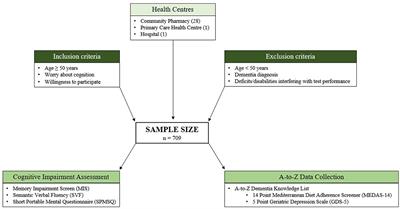3
IntroductionCognitive impairment (CI) is known to be mediated by several risk and protective factors, many of which are potentially modifiable. Therefore, it is important to have up-to-date studies that address a standard assessment of psychosocial, clinical and lifestyle variables.Materials and methodsWe conducted a cross-sectional observational study, with a 24-month timeframe, to estimate the relationship between risk and protective factors associated with dementia, according to the A-to-Z Dementia Knowledge. Participants were considered at CI risk if they tested positive for at least one of three validated CI screening tests: The Memory Impairment Screening, Short Portable Mental State Questionnaire, and Semantic Verbal Fluency. The A-to-Z data Collection included Mediterranean Diet Adherence Screener and Geriatric Depression Scale.ResultsThe estimated prevalence of CI was 22.6% in a sample of 709 patients with an average of 69.3±10.3 years. The risk factors gradually associated with cognitive decline were hypertension, loneliness, and depression. In contrast, the protective factors gradually associated with less cognitive decline were internet use, reading, and intellectually stimulating jobs. Finally, living alone, having diabetes, taking benzodiazepines, and sleeping more than 9 h were statistically significant associated with CI, whereas to do memory training or a family history of dementia was characteristic of patients without CI.ConclusionA joint assessment of t...
You must log in or # to comment.


